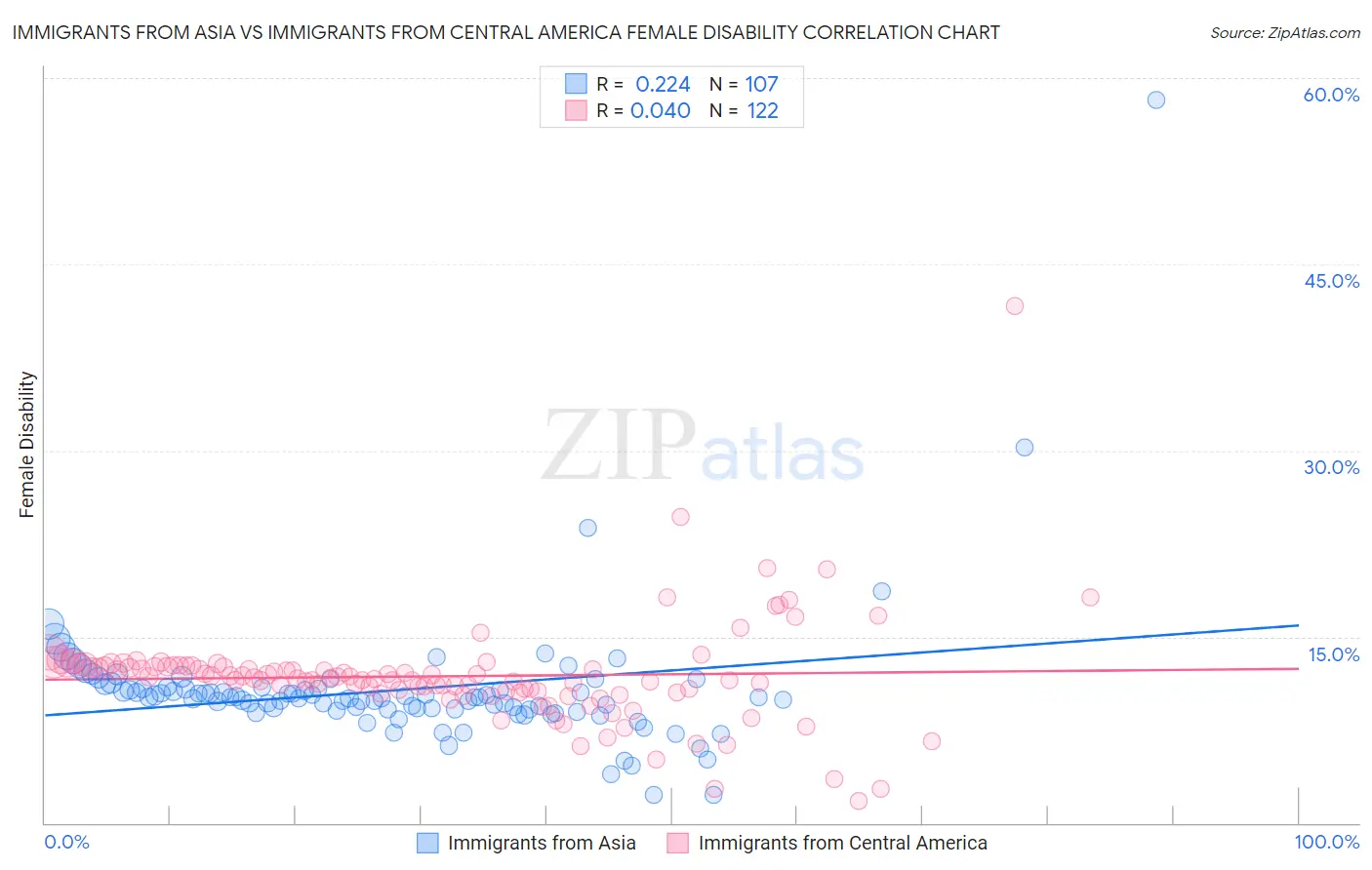Immigrants from Asia vs Immigrants from Central America Female Disability
COMPARE
Immigrants from Asia
Immigrants from Central America
Female Disability
Female Disability Comparison
Immigrants from Asia
Immigrants from Central America
11.0%
FEMALE DISABILITY
100.0/ 100
METRIC RATING
25th/ 347
METRIC RANK
12.1%
FEMALE DISABILITY
67.7/ 100
METRIC RATING
159th/ 347
METRIC RANK
Immigrants from Asia vs Immigrants from Central America Female Disability Correlation Chart
The statistical analysis conducted on geographies consisting of 548,970,010 people shows a weak positive correlation between the proportion of Immigrants from Asia and percentage of females with a disability in the United States with a correlation coefficient (R) of 0.224 and weighted average of 11.0%. Similarly, the statistical analysis conducted on geographies consisting of 536,290,679 people shows no correlation between the proportion of Immigrants from Central America and percentage of females with a disability in the United States with a correlation coefficient (R) of 0.040 and weighted average of 12.1%, a difference of 9.9%.

Female Disability Correlation Summary
| Measurement | Immigrants from Asia | Immigrants from Central America |
| Minimum | 2.2% | 1.8% |
| Maximum | 58.2% | 41.7% |
| Range | 56.0% | 39.9% |
| Mean | 10.7% | 11.8% |
| Median | 10.1% | 11.7% |
| Interquartile 25% (IQ1) | 9.2% | 10.6% |
| Interquartile 75% (IQ3) | 10.8% | 12.6% |
| Interquartile Range (IQR) | 1.7% | 2.1% |
| Standard Deviation (Sample) | 5.7% | 4.2% |
| Standard Deviation (Population) | 5.7% | 4.2% |
Similar Demographics by Female Disability
Demographics Similar to Immigrants from Asia by Female Disability
In terms of female disability, the demographic groups most similar to Immigrants from Asia are Immigrants from Argentina (11.0%, a difference of 0.030%), Argentinean (11.0%, a difference of 0.040%), Immigrants from Turkey (11.1%, a difference of 0.44%), Venezuelan (11.0%, a difference of 0.59%), and Egyptian (11.1%, a difference of 0.72%).
| Demographics | Rating | Rank | Female Disability |
| Immigrants | Iran | 100.0 /100 | #18 | Exceptional 10.8% |
| Immigrants | Venezuela | 100.0 /100 | #19 | Exceptional 10.9% |
| Immigrants | Pakistan | 100.0 /100 | #20 | Exceptional 10.9% |
| Asians | 100.0 /100 | #21 | Exceptional 10.9% |
| Immigrants | Sri Lanka | 100.0 /100 | #22 | Exceptional 10.9% |
| Venezuelans | 100.0 /100 | #23 | Exceptional 11.0% |
| Immigrants | Argentina | 100.0 /100 | #24 | Exceptional 11.0% |
| Immigrants | Asia | 100.0 /100 | #25 | Exceptional 11.0% |
| Argentineans | 100.0 /100 | #26 | Exceptional 11.0% |
| Immigrants | Turkey | 100.0 /100 | #27 | Exceptional 11.1% |
| Egyptians | 100.0 /100 | #28 | Exceptional 11.1% |
| Immigrants | Malaysia | 100.0 /100 | #29 | Exceptional 11.1% |
| Turks | 100.0 /100 | #30 | Exceptional 11.1% |
| Immigrants | Kuwait | 100.0 /100 | #31 | Exceptional 11.1% |
| Immigrants | Australia | 100.0 /100 | #32 | Exceptional 11.1% |
Demographics Similar to Immigrants from Central America by Female Disability
In terms of female disability, the demographic groups most similar to Immigrants from Central America are Immigrants from Guatemala (12.1%, a difference of 0.070%), Guyanese (12.1%, a difference of 0.13%), Immigrants from Ukraine (12.1%, a difference of 0.14%), Guatemalan (12.1%, a difference of 0.16%), and Czech (12.1%, a difference of 0.17%).
| Demographics | Rating | Rank | Female Disability |
| Immigrants | Scotland | 79.3 /100 | #152 | Good 12.0% |
| Sudanese | 79.1 /100 | #153 | Good 12.0% |
| Syrians | 76.9 /100 | #154 | Good 12.1% |
| Ghanaians | 76.6 /100 | #155 | Good 12.1% |
| Moroccans | 72.9 /100 | #156 | Good 12.1% |
| Danes | 72.5 /100 | #157 | Good 12.1% |
| Immigrants | Middle Africa | 72.4 /100 | #158 | Good 12.1% |
| Immigrants | Central America | 67.7 /100 | #159 | Good 12.1% |
| Immigrants | Guatemala | 66.0 /100 | #160 | Good 12.1% |
| Guyanese | 64.7 /100 | #161 | Good 12.1% |
| Immigrants | Ukraine | 64.3 /100 | #162 | Good 12.1% |
| Guatemalans | 63.8 /100 | #163 | Good 12.1% |
| Czechs | 63.6 /100 | #164 | Good 12.1% |
| Immigrants | Oceania | 61.8 /100 | #165 | Good 12.1% |
| Lithuanians | 59.5 /100 | #166 | Average 12.2% |